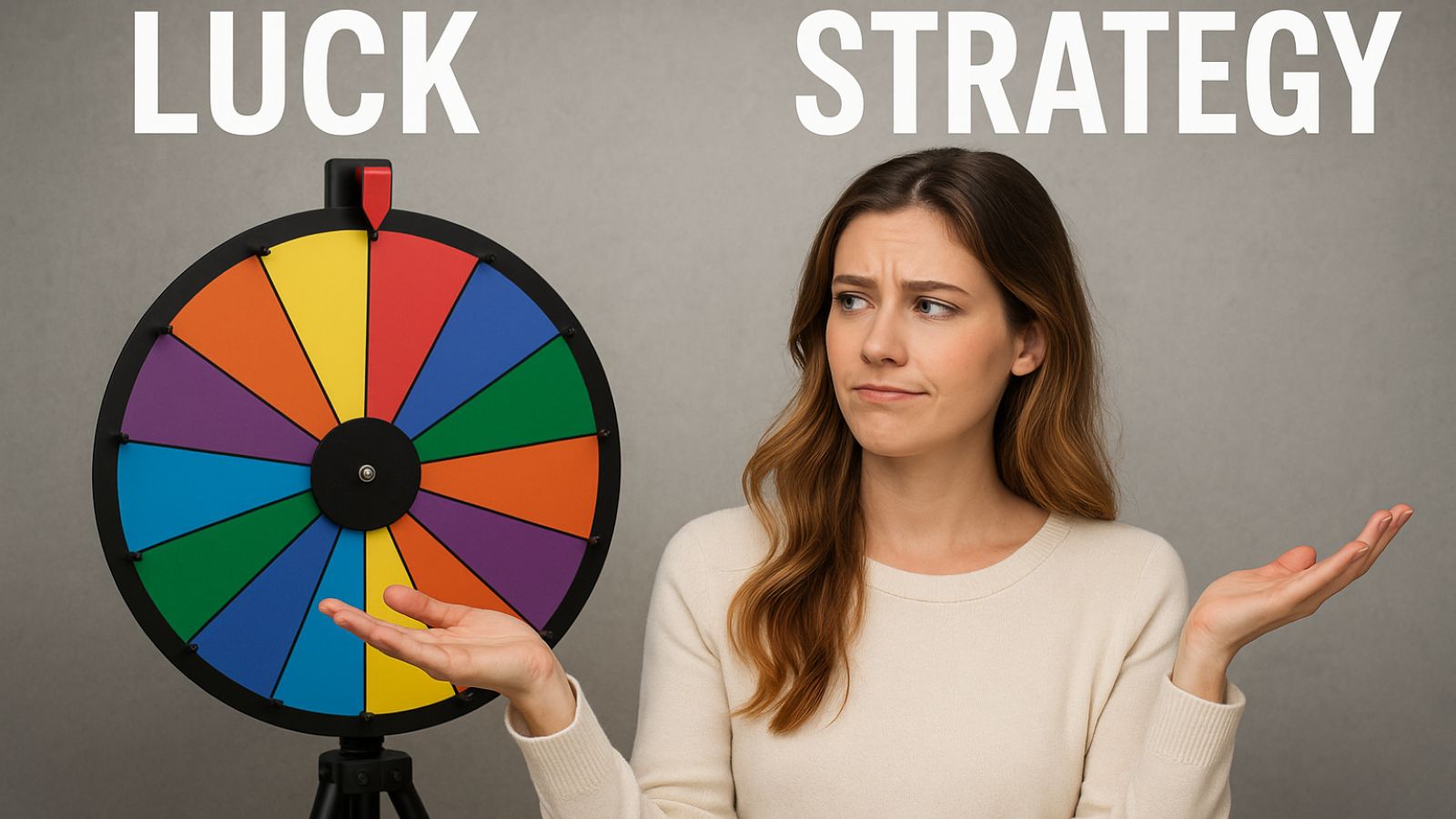When the Wheel Turns, So Do Our Beliefs
Spin the wheel. Watch it whirl. Feel that momentary rush as it slows down — a blend of hope, logic, and superstition all merging into one. Many of us, whether in a carnival, a game app, or a social competition, have believed — at least for a second — that we might be able to outsmart the spin.
But here’s the catch: most wheel spinner games are designed around probability, not precision. Still, that doesn’t stop players from searching for patterns, developing “strategies,” and arguing about whether it’s pure luck or a matter of skill.
In this article, we’ll take a closer look at the psychology, math, and misconceptions behind wheel spinner games. We’ll break down why we believe in strategy even when randomness rules — and why the illusion of control feels so irresistible.
The Myth of Mastery – Why We Believe We Can Beat the Wheel
Humans have an innate desire to find meaning in chaos. When we see a spinning wheel, we’re drawn into its symmetry, its rhythm, and its promise of fairness.
Psychologically, this tendency to “see order in randomness” stems from what cognitive scientists call apophenia — the brain’s pattern-detection system working overtime. We evolved to recognize patterns because they helped our ancestors survive. But in modern games of chance, that same instinct makes us misinterpret coincidence as cause and effect.
Imagine two spins landing on the same color in a row. Immediately, players start forming theories:
-
“It’s due to land on the other color next.”
-
“If I click exactly when it passes the red section, I’ll hit it.”
Both assumptions are false — but they feel rational because our brains associate repetition with predictability.
In short, we hate randomness. We want control, and when randomness doesn’t offer it, we invent it.
The Design of Wheel Spinner Games – Randomness with a Purpose
Most modern wheel spinner games, whether digital or physical, rely on pseudorandom number generation (PRNG) — algorithms that simulate randomness by using mathematical sequences. While not “truly random” (since computers follow patterns), these algorithms are unpredictable enough to feel random to human perception.
In physical wheels, randomness is achieved through mechanical variance: the speed of the spin, air resistance, friction, and the angle of release all interact in unpredictable ways. Even a tiny shift in spin pressure changes the outcome completely.
Game designers intentionally maintain this unpredictability because it sustains engagement. A predictable wheel would lose its thrill. What keeps players hooked is the tension between possibility and uncertainty — the sense that maybe, just maybe, you could tilt the odds in your favor.
This is where the illusion of control enters the picture, a well-documented cognitive bias first identified by psychologist Ellen Langer in her 1975 study. Players believe their actions can influence random outcomes — a belief that makes games both addictive and emotionally rewarding.
The Gambler’s Fallacy – A False Sense of Balance
One of the most persistent myths about wheel games is the idea that outcomes “balance out.” This belief, known as the gambler’s fallacy, is the expectation that past results influence future ones.
If a wheel lands on “red” five times in a row, players assume “blue” is next. But statistically, every spin is independent — previous outcomes have no effect on future probabilities.
This misconception has been thoroughly studied by behavioral economists Daniel Kahneman and Amos Tversky, who explored it in their foundational work on cognitive bias and probability judgment. Our brains naturally prefer symmetry, so streaks of the same outcome feel “wrong” even when they’re perfectly normal.
Understanding this fallacy helps explain why people chase losses, double bets, or switch tactics after patterns emerge — they’re trying to restore balance to a system that doesn’t care about fairness.
Strategy vs. Skill – The Gray Zone of Player Behavior
Can you strategize in a random game? The answer is both yes and no.
In purely random wheel spinners, such as digital games that rely on PRNG or casino-style roulette wheels, there’s no room for skill. Each spin is isolated — meaning that your past actions, timing, or “technique” have zero measurable influence on the next result.
However, in hybrid systems (like game apps that combine chance and player input), small elements of skill can be introduced — for example, reaction speed, timing accuracy, or sequence memory. These hybrid models intentionally blur the line between luck and strategy to increase player engagement.
Even when skill doesn’t matter, though, our brains continue searching for patterns. Players develop rituals — like spinning slower, counting silently, or clicking on specific colors — which mimic strategy but function as comfort mechanisms. They create a sense of agency in an uncontrollable environment.
The Role of Dopamine – Why We Keep Spinning
Every spin, every near-win, every “so close” moment triggers a chemical reaction in your brain. That’s dopamine — the neurotransmitter responsible for motivation, anticipation, and reward.
Studies on variable reinforcement schedules (pioneered by B.F. Skinner in operant conditioning research) reveal that unpredictable rewards are far more stimulating than predictable ones.
Here’s what happens:
-
When you expect to win and do, dopamine spikes slightly.
-
When you don’t expect to win but do, dopamine surges dramatically.
-
When you expect to win but don’t, dopamine dips — but not enough to stop you from trying again.
This neurological rollercoaster is why both casino wheels and digital spinners are so captivating. The possibility of winning is more exciting than the win itself.
The Probability Illusion – Why We Misjudge Odds
Humans are notoriously bad at estimating probabilities. Research by Kahneman and Tversky showed that we rely on heuristics — mental shortcuts — that simplify complex probabilities but often lead to errors.
For example:
-
We overestimate small probabilities (believing rare wins are more likely).
-
We underestimate large probabilities (believing common outcomes are less likely).
-
We’re influenced by vividness — if we remember a big win, we believe it’s bound to happen again.
Wheel spinner games exploit these biases by visually displaying randomness — flashing colors, dramatic sounds, and close calls. The design triggers emotional memory, reinforcing our false probability perceptions.
Randomness Feels Fair – The Paradox of Trust
Ironically, we tend to trust random systems more than human decisions. A randomly generated outcome feels impartial — no favoritism, no manipulation, no emotion.
In behavioral psychology, this is known as procedural fairness — the belief that fairness lies in the process, not the result. A random spin, even if unfavorable, feels more acceptable than a biased choice.
This explains why wheel spinner mechanics are used not just in games, but in classrooms, workplaces, and social media giveaways — they add transparency and perceived equality to selection processes.
How Game Designers Shape Our Perception
Modern game designers understand psychology as deeply as mathematicians understand probability. Many even use principles from behavioral economics and user experience design to manipulate the “feeling” of fairness and control.
Techniques include:
-
Near-miss effects: Landing close to a win creates tension and motivation.
-
Variable timing: Changing spin speed or visual rhythm enhances unpredictability.
-
Feedback reinforcement: Sounds and lights amplify emotional responses.
These elements don’t alter the actual odds — but they dramatically alter our perception of those odds. In essence, game design transforms mathematical randomness into emotional storytelling.
A Simple Diagram – How the Cycle of Belief Works
Curiosity → Play → Random Win → Dopamine Spike → Illusion of Control → Continued Play
↑ ↓
Near Miss & Anticipation — keeps the loop alive
Each spin feeds both psychology and physiology — a feedback loop between expectation and reinforcement.
Debunking Common Myths About Wheel Spinner Games
| Myth | Reality |
|---|---|
| “You can time your spin to increase your odds.” | False. Timing doesn’t affect random generation or physics-based outcomes. |
| “The wheel alternates outcomes to stay fair.” | False. Each spin is independent; no “memory” or balancing mechanism exists. |
| “Algorithms are biased toward certain results.” | In reputable games, algorithms are audited and balanced. Only manipulative systems skew results. |
| “Players can detect patterns with enough observation.” | False. Humans are prone to see false patterns — the essence of apophenia. |
| “Luck evens out in the long run.” | Statistically, no. Each event remains independent, regardless of past performance. |
Real-Life Applications – Beyond Entertainment
Interestingly, the psychology of wheel spinner games extends into education, business, and behavior design. Teachers use spinners to ensure equal participation, marketers use them for promotions, and therapists use randomness as a tool for decision-making exercises.
In these contexts, randomness isn’t about luck — it’s about neutrality and engagement. It encourages spontaneity, fairness, and shared experience, reinforcing how deeply chance influences human interaction.
Insights – What We Can Learn from the Wheel
The wheel is a metaphor — a reflection of life’s balance between choice and chance. It teaches us several key lessons:
-
Perceived control is comforting, not always real.
-
Randomness can feel fairer than logic, because it removes intent.
-
Understanding probability protects us from emotional decision-making.
-
Games of chance reveal how storytelling drives human motivation.
By recognizing these truths, we can appreciate randomness without being deceived by it — enjoying the thrill while staying grounded in reason.
People Also Ask
1. Are wheel spinner games based on luck or skill?
Most are based on luck. However, some hybrid models add timing or decision-based mechanics that simulate skill.
2. Can you predict a spin result?
No. Each spin is independent, whether digital or physical. No method can reliably forecast outcomes.
3. Why do people believe they can beat random systems?
Because of the illusion of control — a bias that makes us feel responsible for random results.
4. Are digital wheels truly random?
They use pseudorandom number generators, which are computationally random enough to appear unpredictable.
5. Why do close calls make us play again?
Near-miss effects trigger dopamine and increase motivation to try once more.
10 Frequently Asked Questions (FAQs)
1. Can strategies improve your odds in random wheel games?
Not significantly. While behavioral patterns may influence engagement, probability remains unaffected.
2. How do algorithms ensure fairness in digital spinners?
Certified systems use random number generation (RNG) protocols that pass statistical randomness tests.
3. Why do people keep playing even after losing repeatedly?
Variable rewards maintain anticipation — a hallmark of dopamine-driven behavior.
4. Do professional gamblers use strategies for wheels like roulette?
Some use betting systems (e.g., Martingale), but these rely on mathematical illusion, not increased probability.
5. Are online spinner games rigged?
Legitimate platforms undergo audits; however, some low-quality apps manipulate RNG to favor the house.
6. What makes wheel spinners psychologically addictive?
Unpredictable reinforcement and visual stimuli exploit the brain’s reward circuitry.
7. Can understanding randomness reduce gambling behavior?
Yes. Awareness of probability biases can decrease emotional impulsivity.
8. Why do some people have “lucky rituals”?
Rituals provide emotional stability and a sense of agency when facing uncertainty.
9. Are wheel spinners suitable for education?
Yes. In cassrooms, they promote fairness and participation, not competition.
10. What’s the healthiest way to enjoy wheel-based games?
Play for fun, not expectation. Treat randomness as entertainment, not investment.
Conclusion: The Real Spin on Luck and Strategy
The debate between luck and strategy isn’t about finding a winner — it’s about understanding the illusion that blurs the two. Wheel spinner games are engineered to mimic fairness and reward, yet their foundation remains statistical randomness.
We can’t outsmart chance, but we can learn from it. The more we understand randomness, the more we recognize its mirror in our own choices — from daily decisions to life’s biggest gambles.
So next time you spin the wheel, remember: the outcome may be random, but how you respond to it is entirely within your control.



